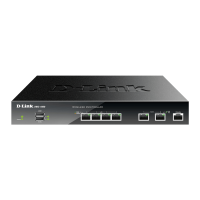D-Link DWC-1000 User Manual 65
Section 4 - Advanced WLAN Conguration
WIDS
The Wireless Intrusion Detection System (WIDS) helps to detect intrusion attempts into the wireless network and
take automatic actions to protect the network.
Congure AP WIDS Settings
Path: Wireless > General > WIDS > AP WIDS Security
The WIDS AP Conguration page allows you to activate or deactivate various threat detection tests and set threat
detection thresholds in order to help detect rogue APs on the wireless network. These changes can be done
without disrupting network connectivity. Since some of the work is done by access points, the controller needs
to send messages to the APs to modify its WIDS operational properties.
Note: The classication settings on the WIDS AP Conguration page are part of the global conguration on the
controller and must be manually pushed to other controllers in order to synchronize that conguration.
Many of the tests are focused on identifying APs that are advertising managed SSIDs, but are not in fact managed
APs. Detecting such an AP means that a network is either miss‐congured or that a hacker set up a honeypot AP
in the attempt to collect passwords or other secure information.
Although operational mode radios can detect most threats, the sentry radios detect the threats faster, especially
when a potential rogue is operating on a dierent channel from any of the managed AP radios. The number
of deployed sentry radios should be sucient to provide coverage by one sentry radio in every geographical
location within the network. A denser sentry deployment may be desirable in order to improve rogue or interferer
signal triangulation.
To congure WIDS AP:
1. Go to Wireless > General > WIDS > AP WIDS Security tab.

